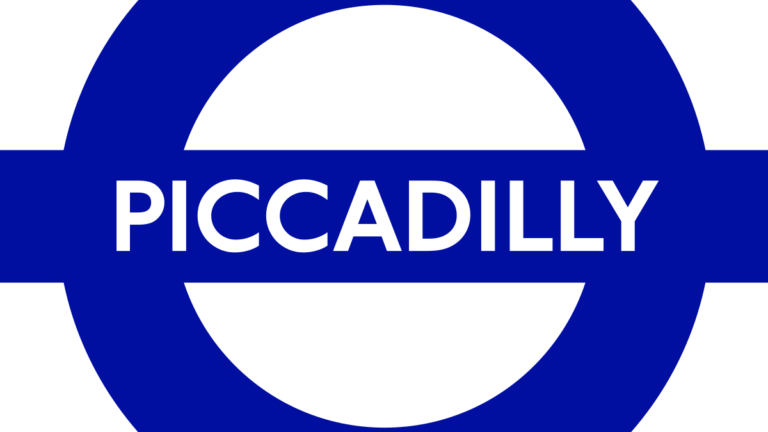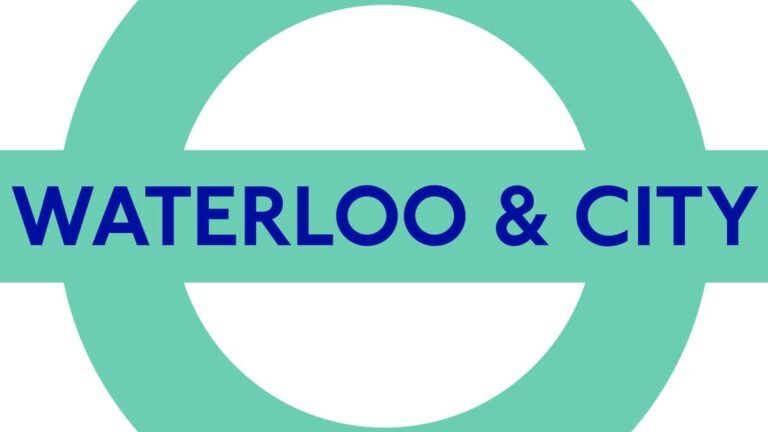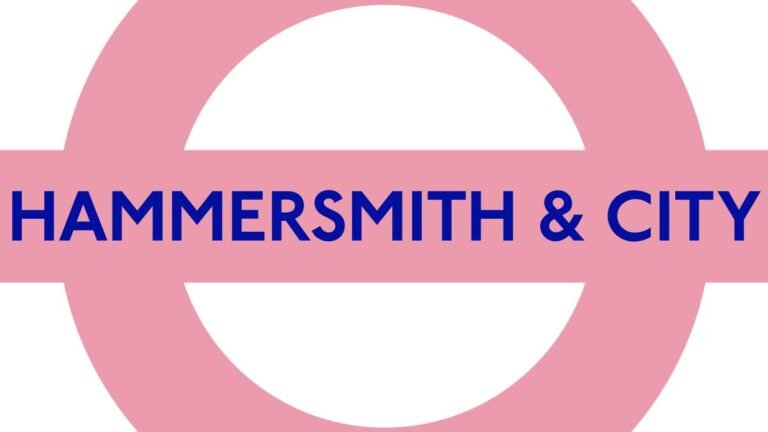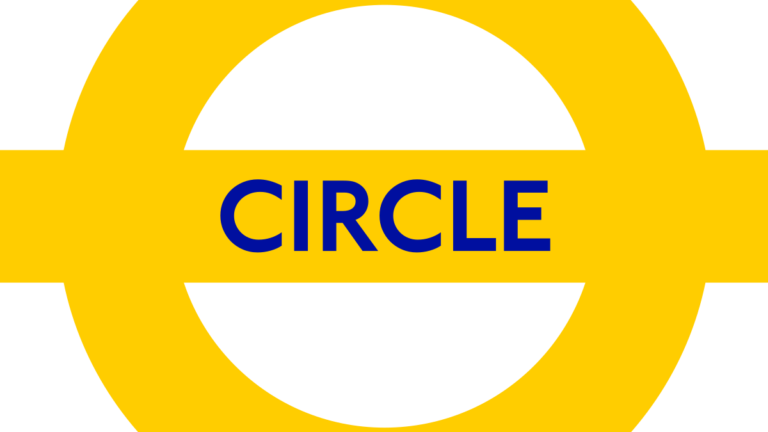London’s District Line map (the “Green Metro Line”) is one of the most extensive and historic routes on the London Underground. Stretching from Upminster in the east to Ealing Broadway and Richmond in the west, it serves 60 stations across the city, making it essential for both commuters and tourists.
This guide covers everything you need to know about the District Line, including:
✔ District Line Description – History, key facts, and why it’s unique
✔ All District Line Stations – Major stops and interchanges
✔ District Line Map and Route – Full journey breakdown
✔ District Line Schedule – First/last trains, frequency, and peak times
✔ Interesting Facts About the District Line – Secrets you never knew
By the end, you’ll be a District Line map expert—whether you’re a daily rider or a first-time visitor!
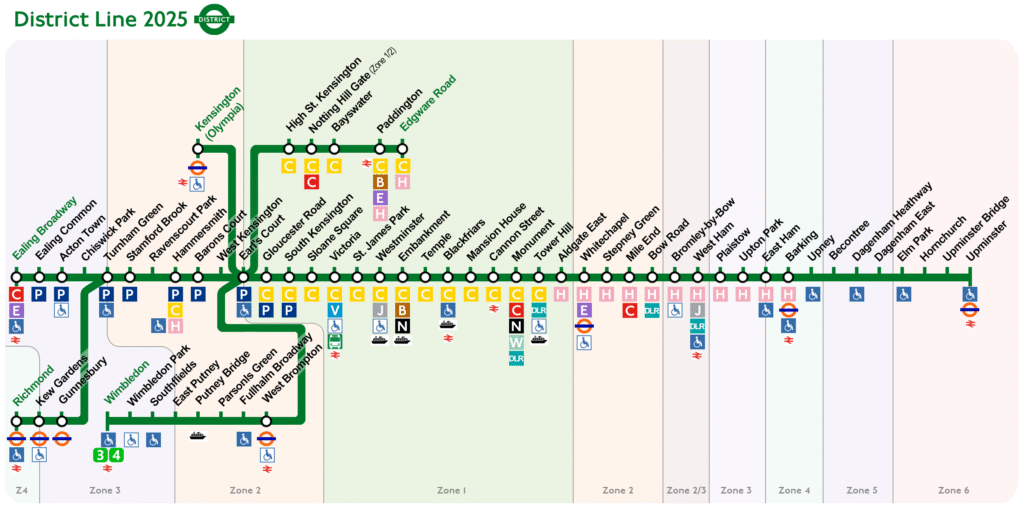
Route 1: Ealing Broadway – Upminster
Route 2: Kensington (Olympia) – Upminster
Route 3: Richmond – Upminster
Route 4: Richmond – Edgware Road (Circle Line)
Route 5: Wimbledon – Upminster
Route 6: Wimbledon – Edgware Road (Circle Line)
1. District Line Description: What Makes It Special?
A. Overview of the District Line
- Color on Tube map: Green (“Green Metro Line”)
- Opened in 1868 (one of the oldest Underground lines)
- Stations served: 60 (one of the most extensive lines)
- Length: 64 km (40 miles)
- Daily ridership: ~700,000 passengers
B. Why Is It Called the “Green Metro Line”?
- It appears in dark green on the Tube map.
- Unlike deep-level Tube lines, most of the District Line runs above ground.
- It shares tracks with National Rail and London Overground in some sections.
C. Unique Features of the District Line
✔ Multiple branches (like a tree, splitting into different routes)
✔ Serves major landmarks (Tower Hill, Westminster, Kensington)
✔ Connects to 5 airports (via transfers to Heathrow, Gatwick, etc.)
2. District Line Stations: Key Stops & Interchanges
The District Line has 60 stations, but these are the most important ones:
Central London Stations
| Station | Key Connections | Nearby Attractions |
| Upminster | Overground | Thames Estuary |
| West Ham | Jubilee, DLR | Olympic Park |
| Tower Hill | Circle Line | Tower of London |
| Monument | Northern, Central | The Shard |
| Cannon Street | National Rail | St. Paul’s Cathedral |
| Blackfriars | Thameslink | Tate Modern |
| Temple | – | Somerset House |
| Embankment | Bakerloo, Northern | London Eye |
| Westminster | Jubilee, Circle | Big Ben |
| Victoria | Victoria Line | Buckingham Palace |
| South Kensington | Piccadilly, Circle | Natural History Museum |
| Earl’s Court | Piccadilly | Kensington Gardens |
| Kensington (Olympia) | Overground | Olympia Exhibition Centre |
| Ealing Broadway | Elizabeth Line | Ealing Studios |
| Richmond | Overground | Richmond Park |
Major Interchanges
- Earl’s Court (split for Ealing/Richmond branches)
- Edgware Road (Circle Line connection)
- Paddington (Elizabeth Line, National Rail)
3. District Line Map & Route: London’s Meandering Green Giant
The District Line isn’t just a Tube route—it’s a geographic chameleon, switching from deep tunnels to open-air viaducts across its four quirky branches. Here’s how to decode its labyrinthine path:

A. Route Breakdown: 4 Branches, 1 Chaotic Family
1. Upminster → Ealing Broadway (Main Trunk)
- Key Stops: Tower Hill, Victoria, Earl’s Court
- Why It Matters: The backbone of the line—connects East London to West without changing trains.
2. Upminster → Richmond (Scenic Detour)
- Key Stops: Kensington Olympia, Turnham Green
- Secret Perk: Only branch serving Kew Gardens (perfect for a foliage escape).
3. Edgware Road → Wimbledon (Commuter Express)
- Key Stops: Paddington, Earl’s Court
- Pro Tip: Avoid 8 AM at Earl’s Court—this branch merges with the Ealing train, creating peak-hour sardine mode.
4. Kensington (Olympia) Shuttle (Weekend Ghost)
- Runs: Saturdays + event days (e.g., Olympia exhibitions).
- Fun Fact: London’s shortest scheduled Tube service (just 1 stop to/from Earl’s Court).
B. District Line Map Insights
✔ Longest Overground Stretch: Upminster → West Ham
- 4.5 miles of fresh air—watch for:
- Beckton Alps (artificial ski slope views).
- Thames Barrier glints near West Ham.
✔ Deepest Station: Sloane Square (16m Down)
- Why so deep? Built beneath the River Westbourne (now a hidden sewer).
✔ Shortest Hop: Temple → Embankment (0.3 Miles)
- Walk it? Takes 7 mins (but mind the rain!).
🎯 TL;DR: District Line Geography Hacks
| Feature | Why It Matters |
| 4 Branches | Ealing/Richmond/Wimbledon options. |
| Upminster Overground | Best skyline views on the Tube. |
| Sloane Square Depth | Hidden river engineering marvel. |
4. District Line Schedule: First & Last Trains, Frequency
A. Operating Hours
- Monday to Saturday: 5:00 AM – 12:30 AM
- Sunday: 6:30 AM – 11:30 PM
B. Train Frequency
| Time | Central Section | Branches (Richmond/Wimbledon) |
| Peak (7-9 AM, 5-7 PM) | Every 2-3 mins | Every 5-7 mins |
| Off-Peak (Daytime) | Every 4-6 mins | Every 8-10 mins |
| Evenings/Sundays | Every 8-10 mins | Every 12-15 mins |
C. Night Tube?
❌ No, but 24-hour services run on Fridays/Saturdays on other lines.
5. Interesting Facts About the District Line
The District Line isn’t just another Tube route—it’s a time capsule of Victorian engineering, royal connections, and spy-movie glamour. Here’s why it’s one of London’s most fascinating lines.
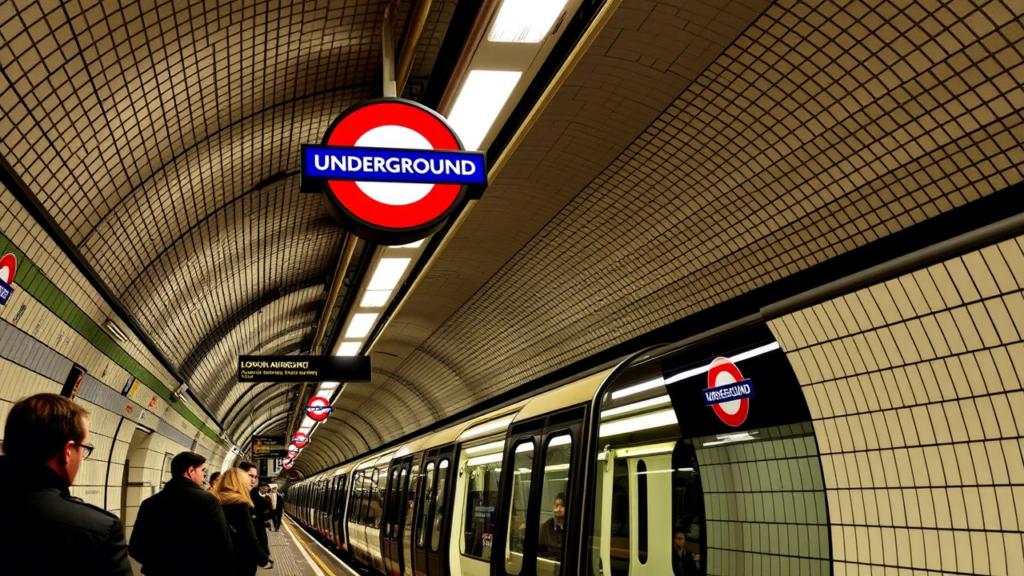
A. Secret History: Where It All Began
1. Steam-Powered Origins (1868)
- First section opened: Westminster to South Kensington (1868), powered by coal-fired steam trains.
- Original name: Metropolitan District Railway (a sibling to the Metropolitan Line).
- Smoky chaos: Passengers endured soot-filled tunnels until electrification (1905).
2. Lost Extensions: The Windsor Connection
- 1883–1885: Ran all the way to Windsor (yes, that Windsor).
- Why it ended: Competition from Great Western Railway killed the route.
B. Unique Features: What Makes It Stand Out
1. Manual Doors Until 1985
- The last Tube line where guards had to slam doors shut by hand.
- Upgrade: Modern S7 trains (2013) finally brought automation.
2. Royal Tube Stop
- Kensington (Olympia): The only station serving a royal palace (Kensington Palace).
- Fun fact: Queen Victoria once took a prototype District Line train in 1864.
3. Hollywood’s Favorite Tube Line
- James Bond (Skyfall): Silva’s underground chase scene.
- Paddington Bear (2014): The Brown family rides the District Line.
- The Crown: Used District Line arches for 1950s London scenes.
C. Ghost Stations: Hidden Beneath the Tracks
1. Mark Lane → Tower Hill (Closed 1967)
- Still visible: Original tiled signs survive in abandoned passages.
- Why closed? Too close to Tower Hill station.
2. Down Street: Churchill’s Secret Wartime Bunker
- 1939–1945: Converted into a cabinet war room (before the Cabinet War Rooms existed).
- Churchill’s late-night haunt: He’d work here during the Blitz, then take the Tube home.
- Today: Sealed off, but tours run occasionally.
3. Brompton Road (Closed 1934)
- WWII use: Anti-aircraft operations center.
- Sold in 2014: For £53 million (now privately owned).
🎯 Why the District Line Still Matters
✔ Scenic variety: From Ealing’s suburbs to Tower Bridge views.
✔ Quirky survivors: Still uses some 1970s D78 stock (phasing out in 2024).
✔ Film buff’s dream: More movie appearances than any other line.
🔍 TL;DR: District Line’s Greatest Hits
| Category | Highlight |
| Oldest | Ran steam trains until 1905 |
| Royalty | Serves Kensington Palace |
| Cinema Star | Skyfall, Paddington, The Crown |
| Ghost Stations | Down Street (Churchill’s bunker) |
Next time you ride, imagine Victorian commuters, wartime spies, and Hollywood cameras sharing your journey!
6. How It Compares to Other Tube Lines
| Feature | District Line | Average Tube Line |
| Stations | 60 | 25-40 |
| Underground % | 40% | 90% |
| Speed | 30-40 mph | 20-30 mph |
| Branches | 4 | 1-2 |
Best For:
✔ Tourists (links major attractions)
✔ Commuting from West/East London
✔ Avoiding traffic (above-ground views)
7. FAQs (Quick Answers)
Q: Why is the District Line so slow?
A: Many level crossings and shared tracks with National Rail.
Q: Does the District Line go to Heathrow?
A: No, but transfer at Earl’s Court for Piccadilly Line.
Q: Which part is the busiest?
A: Victoria to South Kensington (tourist hotspot).
Q: Are there any abandoned stations?
A: Yes, Brompton Road (closed in 1934).
8. Travel hacks for district line: Ride Smarter, Not Harder
The District Line is a workhorse of the Tube network—but it has its quirks. Use these pro tips to dodge crowds, save time, and avoid weekend chaos.
1. Avoid Earl’s Court at Rush Hour
🚫 Peak Times (7:30–9:30 AM / 4:30–6:30 PM):
- One of London’s busiest interchanges (Piccadilly Line + District branches).
- Smart move: Swap at Gloucester Road or South Kensington instead.
✔ Off-Peak Bonus: After 10 AM, the station calms down—ideal for connections.
2. Front/Rear Carriages = More Space
🚇 Why It Works:
- Most passengers cluster near mid-carriage exits (especially at major stops like Victoria).
- Pro Tip: The very front carriage (behind the driver) is often empty—even at rush hour.
📌 Best Stations for This Hack:
- Edgware Road (start of the line = empty trains).
- Wimbledon (terminus = easy boarding).
3. Always Check for Weekend Engineering Works
🔧 The District Line’s Dirty Secret:
- Frequent closures due to aging infrastructure (it’s London’s second-oldest line!).
- Most affected sections:
- Ealing Broadway → Turnham Green (replacement buses galore).
- Tower Hill → Barking (alternative: Hammersmith & City Line).
✔ Survival Tools:
- TfL Weekend Travel Alerts (link).
- Citymapper App: Detours in real-time.
🎯 TL;DR: District Line Cheat Sheet
| Hack | Why It Works |
| Skip Earl’s Court AM | Avoid “sardine mode” at busiest hub. |
| Front/Rear Carriage | Escape crowds—especially at terminals. |
| Weekend Check | District = most closure-prone line. |
Next time you ride, outsmart the masses with these stealth moves!
Final Verdict: Is the District Line Useful? Absolutely!
The District Line might not be the fastest, but it’s one of London’s most versatile routes—blending history, practicality, and even a little glamour. Here’s why it earns its green stripe on the Tube map:
✅ Why the District Line Shines
1. Scenic & Sightseeing-Friendly
✔ Riverside views: Between Tower Hill and Westminster, catch glimpses of the Thames and Big Ben.
✔ Royal stops: Kensington (Olympia) for the palace, St. James’s Park for Buckingham Palace.
2. Well-Connected for Commuters
✔ Cross-London reach: From Ealing to Upminster, it stitches together 12+ key interchanges, including:
- Victoria (National Rail)
- Paddington (Elizabeth Line/Heathrow)
- Edgware Road (Circle/Hammersmith & City)
3. A Ride Through History
✔ Victorian bones: Original 1868 tunnels still in use.
✔ Cinematic fame: Skyfall, Paddington, and Churchill’s wartime bunker at Down Street.
⚠️ The Catch (But It’s Worth It)
- Slower than Elizabeth Line: Frequent stops mean longer journeys.
- Weekend closures: Check TfL alerts—replacement buses are common.
🎯 TL;DR: Who Should Ride?
| For… | Best For |
| Tourists | Sightseeing + fewer crowds than Central Line. |
| West Londoners | Ealing/Wimbledon to City in one seat. |
| History buffs | Steam-era relics + ghost stations. |
Next time you board, admire those vintage curves—you’re riding a living museum!

